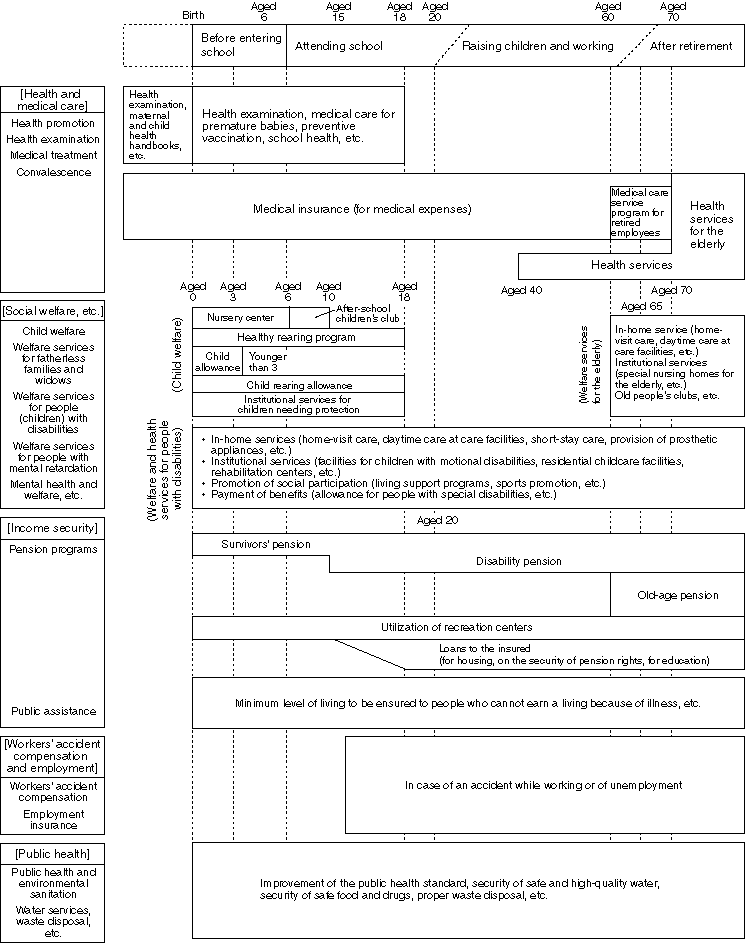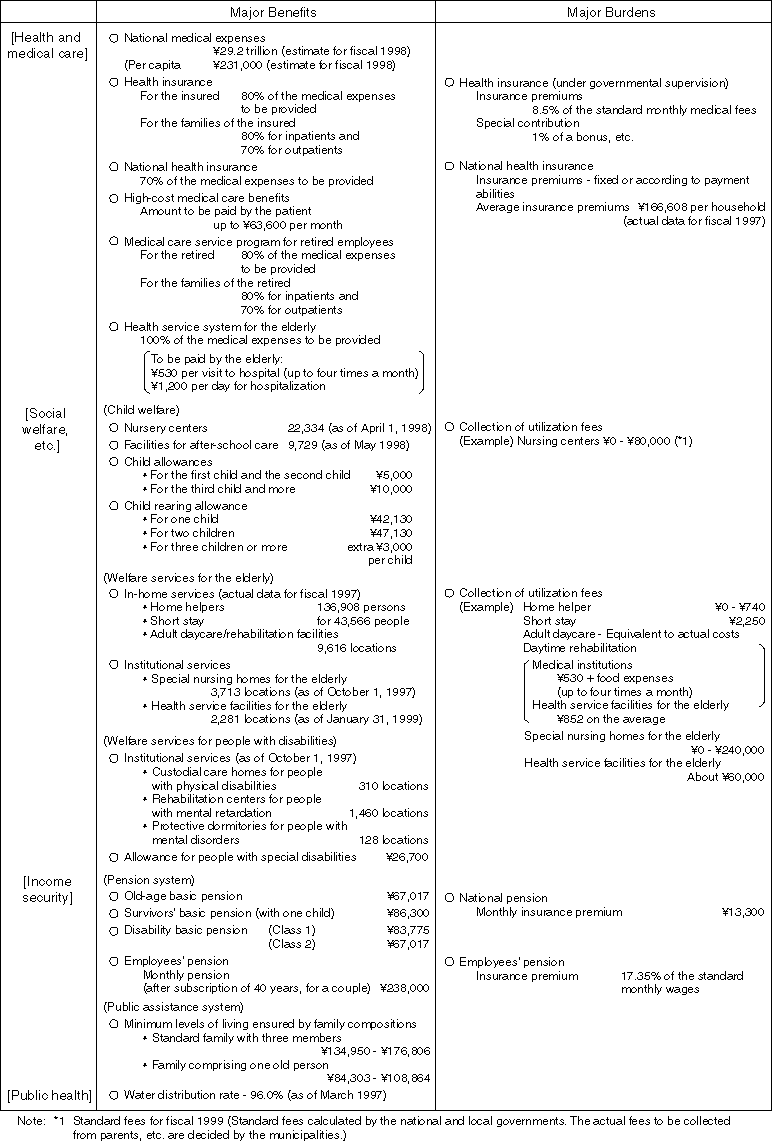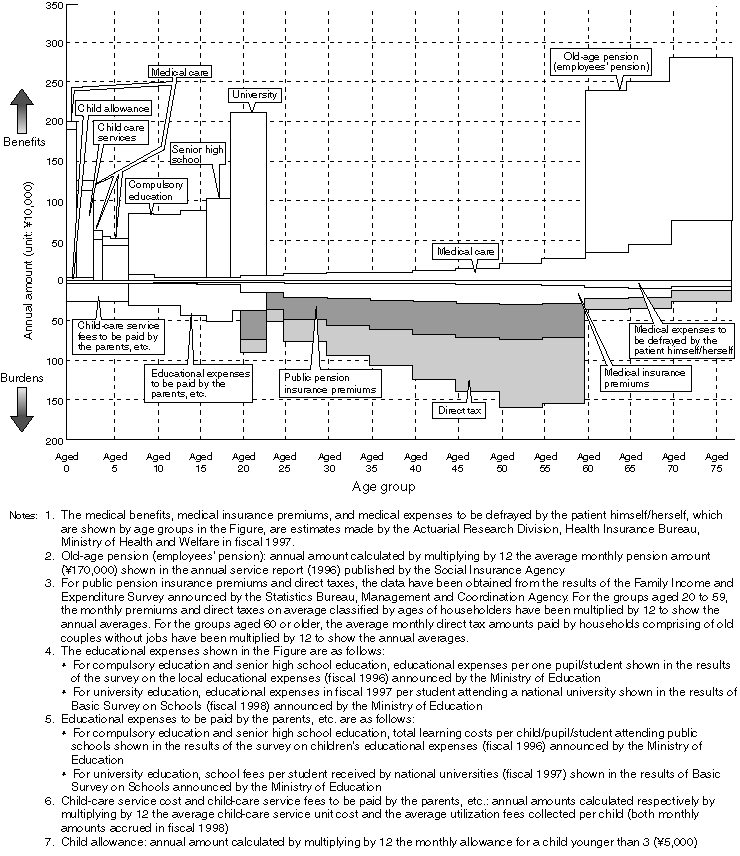
|
|
(Beyond "From the Cradle to the Grave")
After World War II, the United Kingdom took the lead in establishing postwar social security systems and it is often said the country's social security systems ensure security to people "from the cradle to the grave." Such systems, however, are provided not only by the United Kingdom but also by other developed countries, where the establishment of substantial social security systems has been promoted.
Also in Japan, diversified social security systems have been created and promoted with the increase of benefits for more than 50 years since the end of World War II. Presently Japan's social security systems are covering a wider range of risks on a very large scale, and are indispensable for national life.
As shown in Figure 2-1-1, Japan's social security systems cover all the events that require social support throughout people's lives, including illness, injury, disabilities, childcare, unemployment and loss of income. The social security systems may ensure security to people from before their birth (while in the womb) to after their death, beyond "from the cradle to the grave."
(Application of social security in an individual life cycle)
Let us examine the relationship between an individual life and social security according to the life cycle shown in Figure 2-1-1. In relation to the Figure, Table 2-1-2 shows the specific figures concerning the major benefits and burdens of each social security system.
Before a birth of a child, the mother receives prenatal health examination under the maternal and child health program and is covered by medical insurance for illness. For delivery, she receives maternity and childcare lump-sum allowance through medical insurance. After the birth, child allowances are provided till the child becomes three years old. For double-income households, nursery centers are available as the support for childcare and the couples can continue to work while raising their children. Presently, about 1.7 million infants and small children attend nursery centers, which means that one out of five preschoolers attends a nursery center. For children attending school, there are after-school children's clubs and children's community centers for promoting the sound growth of children. For children needing someone to take care of them or those abused by parents, etc., there are residential facilities to protect them. For fatherless families, child rearing allowances may be provided until the children become 18 years old.
Figure 2-1-1. Social Security Systems Supporting National Life

For people born with disabilities or for those suffering disabilities due to accidents, etc., in-home or institutional services, allowances and training programs for social participation are provided under the welfare system for people with disabilities.
For the indigent who have lost their jobs for illness, etc. in youth or at middle age, the employment insurance and public assistance systems support their lives. The public assistance system provides the last resort for old, indigent people. About 0.9 million people are presently receiving public assistance, which means 0.7 person per 100 people.
Table 2-1-2. Social Security Systems Supporting National Life (Outline of the benefits and burdens)

People require medical services for life for treatment of diseases and for maintenance of their health. Under Japan's medical system, people can basically choose medical institutions for receiving medical care and every citizen except for public assistance recipients is obliged to be covered by the public medical insurance system including certain health insurance programs and national heath insurance programs.
Presently about 7.5 million people go to medical institutions every day (about six persons per 100 people), and about 1.5 million are hospitalized (more than one person per 100 people) for receiving medical treatment. The medical expenditures are covered through the medical insurance system, etc. The national total medical expenditures amount to about \29 trillion annually, which means about \230,000 per person on an annual basis (for fiscal 1996). Patients, however, have to pay only about 10% of the expenditures themselves, because high-cost medical care benefits, etc. are provided under the medical insurance system. For example, let us suppose that a person is hospitalized for a month for the treatment of stomach cancer, and has his stomach enucleated. If the medical expenses amount to about \1.2 million, the person will have to pay only \63,600 for the operation, plus about \22,800 (standard amount of money to be paid for meals and medical care). The rest will be covered by medical insurance.
For old-age income security, the role of the public pension system has been increasing its importance year by year. Presently, pensions account for about 60% of the income (about \3.34 million on the average for 1996) of elderly-only households(Note 1). Of all of the elderly-only households, about 60% depend on public pensions as the only income source. About 26 million people (one out of five people in the total population) are presently receiving public pensions including old-age pensions, and as many as 70 million people are covered by pension insurance. In addition to old-age pensions, there are survivors' pensions, which support the lives of people who have lost their spouses. Besides disability pensions are available for providing income security to people with disabilities.
For people to lead safe and comfortable lives throughout their lives, public health and environmental sanitation need to be promoted including provision of safe and high-quality water, securing of safe food and pharmaceuticals, and proper disposal of waste.
As explained above, the social security systems have been responding to various situations in people's lives. In the age of an 80-year life, people may face, in their long lives, events or risks that will make them feel uneasy including illness, disabilities, unemployment, decrease of income, unforeseen accidents and retirement resulting in lower earnings. The social security systems exist for enabling people to provide against diversified risks in their daily lives and for minimizing the influences exerted by such risks when they are actually incurred by giving supports to independence or to household functions for the security and stabilization of their lives.
2. Benefits and Burdens in a Life Cycle
How social security benefits and burdens interrelated in a life cycle? Figure 2-1-3 shows an outline of the benefits of public services (services to be called "social services"(Note 2)) and the burdens to be shared by each person under the social security systems based on certain assumptions. Benefits and burdens in one's childhood are actually provided to or imposed on his/her parents, but here they are assumed to be provided to or imposed on the person himself/herself, which is more convenient for clarifying the relationship between social security benefits and burdens in a life cycle.
For benefits, annual amounts are shown regarding child allowance, childcare service, education at public elementary, junior high and senior high schools and at national universities, medical services for all of the age groups, and public pension for the elderly (here old-age employees' pension). For burdens, the amounts of money to be paid by each person are shown in relation to childcare, education, medical care services, average social insurance premiums and direct taxes.
(Note 1)
Here "elderly-only households" mean households comprised of men aged 65 or older and/or women aged 60 or older only, and those comprised of such people plus persons aged younger than 18.
(Note 2)
"Social services" generally mean the services that are closely related to and form the basis for national life. Such services need to be provided in a stable manner and be improved in quality, and the public sector provides such services or is institutionally involved with them in cooperation with private providers. Health, medical care and welfare services are typical examples of social services, and educational services are also regarded as social services. As mentioned in Chapter 1, health, medical care and welfare services that are separately described in Japan are often expressed collectively as "social services" in the Western Europe.
Figure 2-1-3. Social Service Benefits and Burdens in a Life Cycle

Every member of society has to pay taxes and social insurance premiums, and the burdens increase with the increase of income while he/she is working. For social service benefits, a certain amount of money is provided to the person at each stage of his/her life. As child allowance, as much as \175,000 is provided in total before the person becomes three years old. For childcare services, if they are fully utilized (from age 0 through entrance to school), the monetary value will be about \5.5 million in total. For education, services equivalent to about \10 million in total are provided for 12 years at an elementary school, a junior high school and a senior high school, and services provided at a national university have monetary value of about \8 million in total for four years. The costs for such services are partly paid by the user as child-care fees or school fees and are also financed by tax revenues, etc. When the person gets old, he/she will receive old-age pension (about \2 million annually for old-age employees' pension), which is mainly financed by social insurance premiums. Besides as much as \760,000 will be provided as medical benefits to the old person, while the average amount of medical benefits of all the age groups is about \230,000 per person on an annual basis. (It should be noted that these figures are estimates made based on certain assumptions.) The services listed in the Figure are just some examples and there are far more kind of public services including social services for dealing with waste, public health and unemployment; and law enforcement services, public transport facilities and public roads that do not have the specific beneficiaries.
These social security services and other public services ensure each citizen a convenient and stable life and a certain standard of living for life. In discussing social security burdens, enough attentions must be paid also to social security benefits.